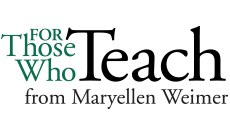The line between collaboration and cheating is fuzzy. It’s still clear at the edges, but messy in the middle. When students are working in groups, searching for a solution to a problem, looking through possible answers for the best one, or sorting out material to include in a presentation, that’s collaboration. When one student in the group solves the problem and everyone else copies the answer, that’s cheating. When one student fails to deliver material she or he’s been assigned and the rest of the group covers, that’s cheating.
 But what about when students study together? Given what we know about how much they can learn from and with each other, it makes sense to encourage students to work together on course content. To us that means collectively looking for answers, explaining things to each other, and using questions to test their knowledge. But what if they divide up the homework problems or study questions so that each person does only a few, but everyone gets the answers?
But what about when students study together? Given what we know about how much they can learn from and with each other, it makes sense to encourage students to work together on course content. To us that means collectively looking for answers, explaining things to each other, and using questions to test their knowledge. But what if they divide up the homework problems or study questions so that each person does only a few, but everyone gets the answers?
Collaboration on exams or quizzes further highlights the messiness of the distinctions. If a student admits to a group working on quiz questions that he doesn’t know an answer and someone else in group identifies the right answer, explains what makes it right, and that explanation enables the first student to understand, has cheating occurred? For exams, must a student discover all answers working alone? The question can be framed more globally, when does collaboration cross the line and become cheating?
Teachers have the responsibility to assess individual mastery of the material. Grades provide a measure of how well an individual knows something. When students collaborate, when they produce work collectively, that makes it much more difficult to determine who knows what and how well they know it. Promoting collaboration and preventing cheating can feel like one of those spots between a rock and hard place.
The distinctions matter because collaboration is an expectation in most professional settings. Professionals “cheat,” as we usually define it. If they don’t know an answer, they look it up. If they don’t know how to do something, they ask someone to show them. Most decisions are group decisions. Who contributed what is of little concern; it’s the quality of the decision that matters.
Are we conveying mixed messages if we put a problem on the board and tell students to work on it with someone seated nearby, but then silently expect all homework to be completed independently? Do they see what differentiates in-class collaboration from the individual work we require that they do for grades? As far as that goes, how clear is our own thinking about what makes them different?
If we don’t understand the distinctions, then we don’t have much hope of clarifying them for students. Students already have permissive attitudes about cheating—so many of them do it, despite our efforts to prevent it. If we’re teaching students in that traditional 18-23-year-old cohort, then there’s the added power of peer pressure. If the student asking for your answer is a friend, can you say no without doing damage to the friendship?
Unfortunately, it’s also possible for groups to collaborate with the intent of cheating—the giving and taking of answers without any attempt at learning. We focus our efforts on the person who’s cheated—the one who’s gotten the answer from somebody else. We don’t pay much attention to those who enabled the cheating—the ones giving away the solutions and facing no consequences when they are in fact co-conspirators.
Finally, are we so focused on preventing cheating that we’re neglecting to teach the skills of collaboration? I’m wondering if the place to start is by exploring with students what it means to work collaboratively, how everyone has the responsibility to contribute, and why it’s everyone’s responsibility to prevent the undeserved taking of ideas and information from others. That doesn’t mean everyone must always know the answer, but everyone ought to have ideas about the possible answers or at least some thoughts about how to probe the problem further. Handing out an answer to somebody who hasn’t done any work is different from trying to help someone who’s struggling but still working to understand the content. Effort on the part of the receiver is key.
Please share your thoughts. Writing this post has stimulated a lot of thinking (and rewriting). I’m not sure I’ve gotten us to good answers yet.
© Magna Publications. All rights reserved.






